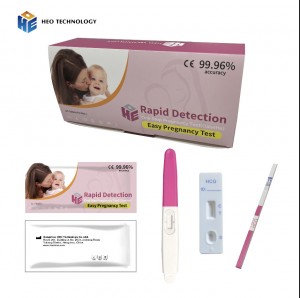OEM/ODM Human chorionic gonadotropin (HCG) Rapid Test Kit
OEM/ODM Approval Human chorionic gonadotropin (HCG) Rapid Test
[Background]
The hCG Pregnancy Midstream Test (Urine) is a rapid chromatographic immunoassay for the qualitative detection of human chorionic gonadotropin in urine to aid in the early detection of pregnancy
[Detection principle]
The hCG Pregnancy Midstream Test (Urine) is a rapid chromatographic immunoassay for the qualitative detection of human chorionic gonadotropin in urine to aid in the early detection of pregnancy. The test uses two lines to indicate results. The test line utilises a combination of antibodies including monoclonal hCG antibody to selectively detect elevated levels of hCG. The control line is composed of goat polyclonal antibodies and colloidal gold particles. The assay is conducted by adding a urine specimen to the specimen well of the test device and observing the formation of coloured lines. The specimen migrates via capillary action along the membrane to react with the coloured conjugate. Positive specimens react with the specific antibody hCG coloured conjugate to form a red line at the test line region of the membrane. Absence of this red line suggests a negative result. To serve as a procedural control, a red line will always appear in the control line region indicating that proper volume of specimen has been added and membrane wicking has occurred.
[Product composition]
Test midstream (25 bags/ box)
Desiccant (1pc/bag)
Instruction ( 1 pc/box)
[Usage]
Please read the operating instructions carefully before testing, and restore the test card and the sample to be tested to room temperature of 2–30℃.
- The test device must remain in the sealed pouch until use. DO NOT FREEZE. Do not use beyond the expiration date.
- All specimens should be considered potentially hazardous and handled in the same manner as an infectious agent. The used test should be discarded according to local regulations.
- Hold the midstream test by the capped Thumb Grip with the exposed Absorbent Tip pointing downward directly into your urine stream for at least 10 seconds until it is thoroughly wet. See the illustration opposite. Note: Do not urinate either on theTest or Control windows. If you prefer, you can urinate into a clean and dry container, then dip only the Absorbent Tip of the midstream test into the urine for at least 10 seconds
[Result judgment]
POSITIVE: Two distinct red lines appear*. One line should be in the control line region (C) and another line should be in the test line region (T).
NOTE: The intensity of the colour in the test line region (T) may vary depending on the concentration of hCG present in the specimen. Therefore, any shade of colour in the test line region (T) should be considered positive.
NEGATIVE: One red line appears in the control line region (C). No apparent coloured line appears in the test line region (T).
INVALID: Control line fails to appear. Insufficient specimen volume or incorrect procedural techniques are the most likely reasons for control line failure. Review the procedure and repeat the test with a new test. If the problem persists, discontinue using the test kit immediately and contact your local supplier.
[Application limitations]
1. The hCG Pregnancy Midstream Test (Urine) is a preliminary qualitative test, therefore, neither the quantitative value nor the rate of increase in hCG can be determined by this test.
2. Very dilute urine specimens as indicated by a low specific gravity, may not contain representative levels of hCG. If pregnancy is still suspected, a first morning urine specimen should be collected 48 hours later and tested.
3. Very low levels of hCG (less than 50 mIU/mL) are present in urine specimens shortly after implantation. However, because a significant number of first trimester pregnancies terminate for natural reasons,5 a test result that is weakly positive should be confirmed by retesting with a first morning urine specimen collected 48 hours later.
4. This test may produce false positive results. A number of conditions other than pregnancy, including trophoblastic disease and certain non-trophoblastic neoplasms including testicular tumours, prostate cancer, breast cancer and lung cancer can cause elevated levels of hCG.6,7 Therefore, the presence of hCG in urine should not be used to diagnose pregnancy unless these conditions have been ruled out.
5. This test may produce false negative results. False negative results may occur when the levels of hCG are below the sensitivity level of the test. When pregnancy is still suspected, a first morning urine specimen should be collected 48 hours later and tested. In cases where pregnancy is suspected and the test continues to produce negative results, see a physician for further diagnosis.
6. This test provides a presumptive diagnosis for pregnancy. A confirmed pregnancy diagnosis should only be made by a physician after all clinical and laboratory findings have been evaluated.
[Storage and expiration]
This product should be stored at 2 ℃–30℃ dry place away from light and not frozen; Valid for 24 months. See the outer package for the expiration date and batch number.












